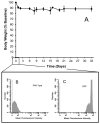Cross-circulation and cell distribution kinetics in parabiotic mice
- PMID: 21503883
- PMCID: PMC3160515
- DOI: 10.1002/jcp.22796
Cross-circulation and cell distribution kinetics in parabiotic mice
Abstract
Blood-borne nucleated cells participate not only in inflammation, but in tissue repair and regeneration. Because progenitor and stem cell populations have a low concentration in the blood, the circulation kinetics and tissue distribution of these cells is largely unknown. An important approach to tracking cell lineage is the use of fluorescent tracers and parabiotic models of cross-circulation. Here, we investigated the cross-circulation and cell distribution kinetics of C57/B6 GFP(+)/wild-type parabionts. Flow cytometry analysis of the peripheral blood after parabiosis demonstrated no evidence for a "parabiotic barrier" based on cell size or surface characterstics; all peripheral blood cell subpopulations in this study reached equilibrium within 14 days. Whole blood fluorescence analysis indicated that the mean exchange flow rate was 16 µl/h or 0.66% of the circulating blood volume per hour. Studies of peripheral lymphoid organs indicated differential cell distribution kinetics. Some subpopulations, such as CD8(+) and CD11c(+), equilibrated in both lymph nodes and spleen indicating a residence time <28 days; in contrast, other lymphocyte subpopulations, such as B220(+) and CD4(+) cells, had not yet reached equilibrium at 28 days. We conclude that parabiosis can provide important insights into defining tissue distribution, residence times, and recirculating pools using fluorochrome markers of cell lineage.
Copyright © 2011 Wiley Periodicals, Inc.
Figures
Similar articles
-
Shared circulation in parabiosis leads to the transfer of bone phenotype from gld to the wild-type mice.Cell Immunol. 2005 Feb;233(2):133-9. doi: 10.1016/j.cellimm.2005.04.010. Cell Immunol. 2005. PMID: 15950207
-
Mouse parabiosis model promotes recovery of lymphocytes in irradiated mice.Int J Radiat Biol. 2021;97(11):1589-1596. doi: 10.1080/09553002.2021.1969464. Epub 2021 Aug 31. Int J Radiat Biol. 2021. PMID: 34399659
-
The immune influence of a parabiosis model on tumour-bearing mice.Swiss Med Wkly. 2018 Oct 3;148:w14678. doi: 10.4414/smw.2018.14678. eCollection 2018 Sep 24. Swiss Med Wkly. 2018. PMID: 30294773
-
Role of Cell-Intrinsic and Environmental Age-Related Changes in Altered Maintenance of Murine T Cells in Lymphoid Organs.J Gerontol A Biol Sci Med Sci. 2018 Jul 9;73(8):1018-1026. doi: 10.1093/gerona/glx102. J Gerontol A Biol Sci Med Sci. 2018. PMID: 28582491 Free PMC article.
-
Contribution made by parabiosis to the understanding of energy balance regulation.Biochim Biophys Acta. 2013 Sep;1832(9):1449-55. doi: 10.1016/j.bbadis.2013.02.021. Epub 2013 Mar 5. Biochim Biophys Acta. 2013. PMID: 23470554 Free PMC article. Review.
Cited by
-
Single-Cell RNA Sequencing Identifies Candidate Renal Resident Macrophage Gene Expression Signatures across Species.J Am Soc Nephrol. 2019 May;30(5):767-781. doi: 10.1681/ASN.2018090931. Epub 2019 Apr 4. J Am Soc Nephrol. 2019. PMID: 30948627 Free PMC article.
-
Alveolar macrophage dynamics in murine lung regeneration.J Cell Physiol. 2012 Sep;227(9):3208-15. doi: 10.1002/jcp.24009. J Cell Physiol. 2012. PMID: 22105735 Free PMC article.
-
Differential contribution of monocytes to heart macrophages in steady-state and after myocardial infarction.Circ Res. 2014 Jul 7;115(2):284-95. doi: 10.1161/CIRCRESAHA.115.303567. Epub 2014 May 1. Circ Res. 2014. PMID: 24786973 Free PMC article.
-
Is leptin the parabiotic "satiety" factor? Past and present interpretations.Appetite. 2013 Feb;61(1):111-8. doi: 10.1016/j.appet.2012.08.006. Epub 2012 Aug 10. Appetite. 2013. PMID: 22889986 Free PMC article. Review.
-
Evidence for RNA or protein transport from somatic tissues to the male reproductive tract in mouse.Elife. 2023 Mar 27;12:e77733. doi: 10.7554/eLife.77733. Elife. 2023. PMID: 36971355 Free PMC article.
References
-
- Abe S, Boyer C, Liu X, Wen FQ, Kobayashi T, Fang Q, Wang X, Hashimoto M, Sharp JG, Rennard SI. Cells derived from the circulation contribute to the repair of lung injury. Am J Respir Crit Care Med. 2004;170(11):1158–1163. - PubMed
-
- Aicher A, Rentsch M, Sasaki K, Ellwart JW, Fandrich F, Siebert R, Cooke JP, Dimmeler S, Heeschen C. Nonbone marrow-derived circulating progenitor cells contribute to postnatal neovascularization following tissue ischemia. Circ Res. 2007;100(4):581–589. - PubMed
-
- Barisic-Dujmovic T, Boban I, Clark SH. Fibroblasts/Myofibroblasts that Participate in Cutaneous Wound Healing are not Derived from Circulating Progenitor Cells. J Cell Physiol. 2010;222(3):703–712. - PubMed
-
- Bunster E, Meyer RK. An improved method of parabiosis. Anat Rec. 1933;57:339–343.
-
- Duschl L, Niekau B. Untersuchungen über die Gefäßskommunikation zwischen parabiosierten Ratten Langenbeck’s. Arch Surg. 1924;186:76–97.
Publication types
MeSH terms
Substances
Grants and funding
LinkOut - more resources
Full Text Sources
Research Materials







